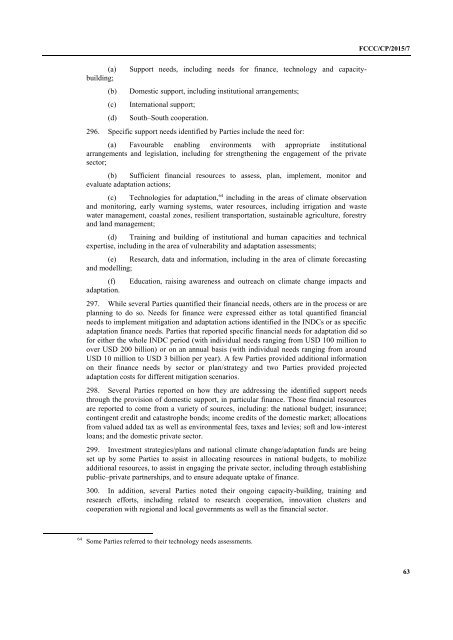FCCC/CP/2015/7
1PYuHQM
1PYuHQM
You also want an ePaper? Increase the reach of your titles
YUMPU automatically turns print PDFs into web optimized ePapers that Google loves.
<strong>FCCC</strong>/<strong>CP</strong>/<strong>2015</strong>/7<br />
Support needs, including needs for finance, technology and capacity-<br />
(a)<br />
building;<br />
(b)<br />
(c)<br />
(d)<br />
Domestic support, including institutional arrangements;<br />
International support;<br />
South–South cooperation.<br />
296. Specific support needs identified by Parties include the need for:<br />
(a) Favourable enabling environments with appropriate institutional<br />
arrangements and legislation, including for strengthening the engagement of the private<br />
sector;<br />
(b) Sufficient financial resources to assess, plan, implement, monitor and<br />
evaluate adaptation actions;<br />
(c) Technologies for adaptation, 64 including in the areas of climate observation<br />
and monitoring, early warning systems, water resources, including irrigation and waste<br />
water management, coastal zones, resilient transportation, sustainable agriculture, forestry<br />
and land management;<br />
(d) Training and building of institutional and human capacities and technical<br />
expertise, including in the area of vulnerability and adaptation assessments;<br />
(e) Research, data and information, including in the area of climate forecasting<br />
and modelling;<br />
(f)<br />
adaptation.<br />
Education, raising awareness and outreach on climate change impacts and<br />
297. While several Parties quantified their financial needs, others are in the process or are<br />
planning to do so. Needs for finance were expressed either as total quantified financial<br />
needs to implement mitigation and adaptation actions identified in the INDCs or as specific<br />
adaptation finance needs. Parties that reported specific financial needs for adaptation did so<br />
for either the whole INDC period (with individual needs ranging from USD 100 million to<br />
over USD 200 billion) or on an annual basis (with individual needs ranging from around<br />
USD 10 million to USD 3 billion per year). A few Parties provided additional information<br />
on their finance needs by sector or plan/strategy and two Parties provided projected<br />
adaptation costs for different mitigation scenarios.<br />
298. Several Parties reported on how they are addressing the identified support needs<br />
through the provision of domestic support, in particular finance. Those financial resources<br />
are reported to come from a variety of sources, including: the national budget; insurance;<br />
contingent credit and catastrophe bonds; income credits of the domestic market; allocations<br />
from valued added tax as well as environmental fees, taxes and levies; soft and low-interest<br />
loans; and the domestic private sector.<br />
299. Investment strategies/plans and national climate change/adaptation funds are being<br />
set up by some Parties to assist in allocating resources in national budgets, to mobilize<br />
additional resources, to assist in engaging the private sector, including through establishing<br />
public–private partnerships, and to ensure adequate uptake of finance.<br />
300. In addition, several Parties noted their ongoing capacity-building, training and<br />
research efforts, including related to research cooperation, innovation clusters and<br />
cooperation with regional and local governments as well as the financial sector.<br />
64 Some Parties referred to their technology needs assessments.<br />
63


